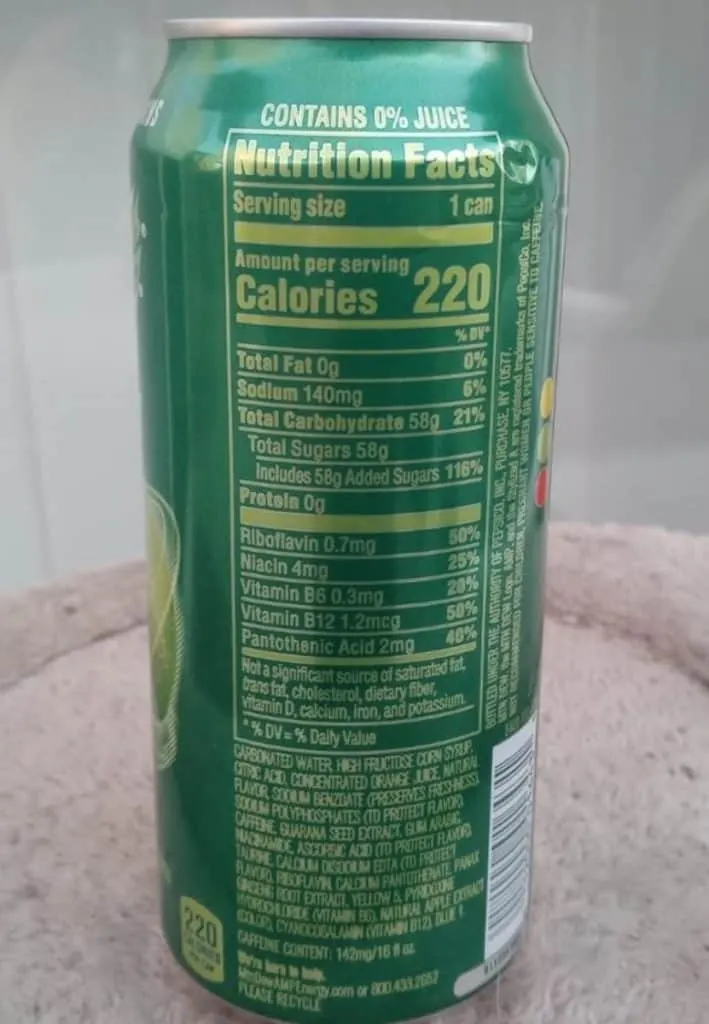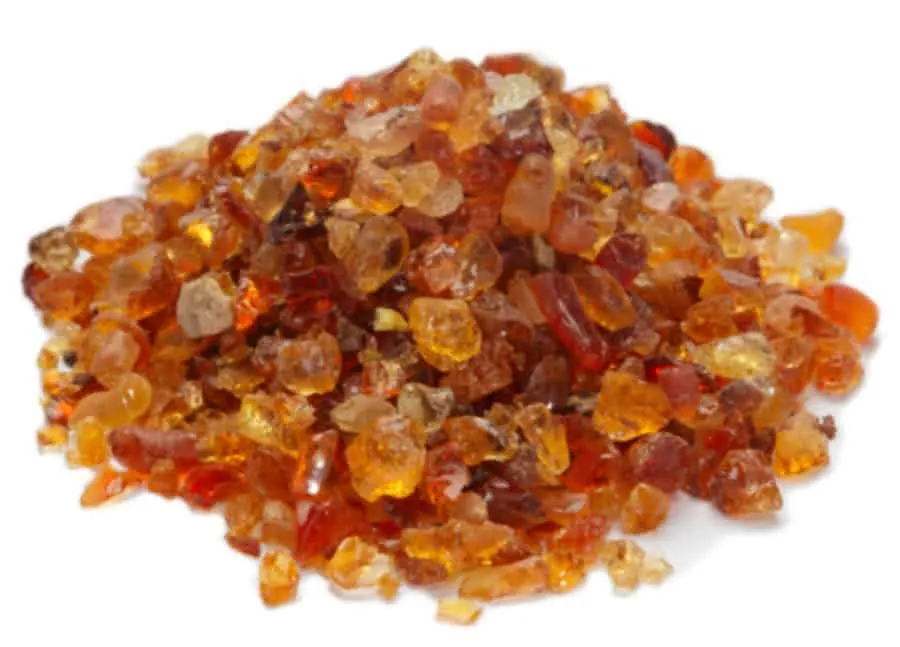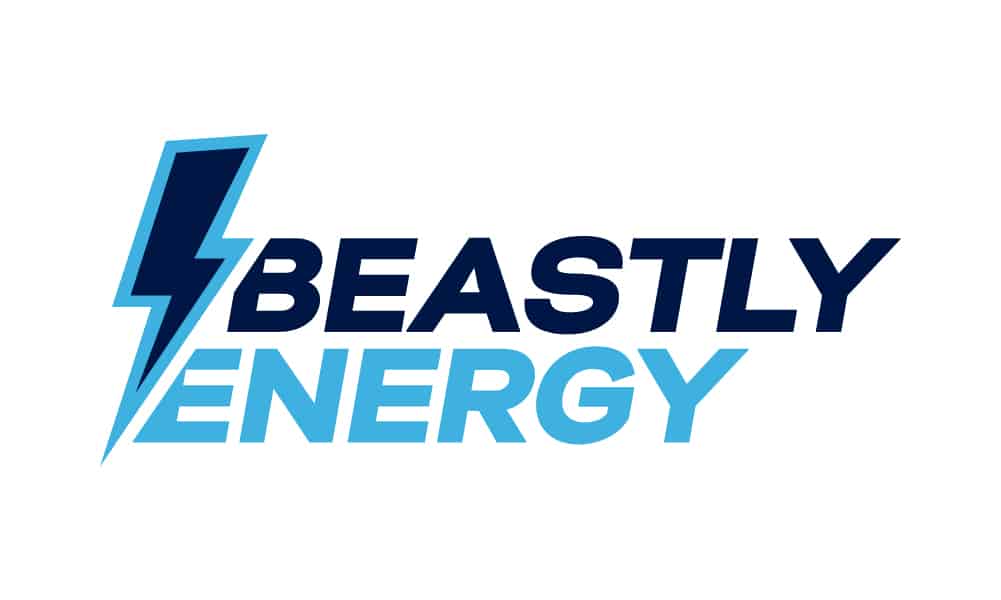AMP, or “Mountain Dew AMP”, as it is officially known, is one brand you’re likely to hear about in any conversation about energy drinks.
Originally produced by PepsiCo, AMP was distributed under Mountain Dew before getting its own brand in 2013. It has since reverted back to the Mountain Dew branding in 2018.
Made with regular Mountain Dew’s base flavor formula, AMP combines Taurine, B vitamins, Ginseng and Guarana with simple and complex carbohydrates such as maltodextrin — all in a great-tasting fusion of citrus flavors.
Bevnet.com

However, despite its popularity, you may have heard, or read about, certain issues that people have brought up about AMP’s ingredient list, particularly its sugar content.
You may be looking for some cold hard facts that not many websites are willing to divulge. Well, your search ends here, because I will be analyzing AMP’s ingredients list and giving you all the juicy details.
On the upside, a single can of AMP contains a safe level of caffeine and loads of nutritious vitamins and extracts. On the downside, it also contains two food dyes that may be harmful to your health, and also an excessive amount of sugar.
Read on for a full breakdown of the ingredient list of AMP Energy Drink, and understand the concerns behind the sugar content and the controversial additives used in the product.
Contents
AMP Energy Drink Nutrition Facts
| NUTRIENT | QUANTITY |
| Calories | 200 |
| Total Carbohydrate | 58g |
| Sodium | 140mg |
| Vitamin B2 or Riboflavin | 0.7mg |
| Vitamin B3 or Niacin (as niacinamide) | 4mg |
| Vitamin B5 or Pantothenic Acid (as calcium pantothenate) | 2mg |
| Vitamin B6 or Pyridoxine (as pyridoxine hydrochloride) | 0.3mg |
| Vitamin B12 or Cobalamin (as cyanocobalamin) | 1.2mg |
AMP Energy Drink Ingredients
AMP also contains the following ingredients:
- Carbonated water
- High fructose corn syrup
- Citric acid
- Concentrated orange juice
- Natural flavor
- Sodium benzoate
- Sodium polyphosphates
- Caffeine
- Guarana seed extract
- Gum Arabic
- Vitamin C or ascorbic acid
- Taurine
- Calcium Disodium EDTA
- Panax ginseng root extract
- Yellow 5
- Natural apple extract
- Blue 1
Those marked in red are controversial additives that are known to have a negative reputation in regards to food safety. Read on to find out more about these ingredients.
Caffeine in AMP Energy Drink
A 16 fl.oz can of AMP carries 142mg of caffeine.
By energy drink standards, AMP holds a reasonable amount of caffeine, not too much, and still enough to give a boost. It can be compared to the energy drink Monster, which contains 160mg in one can.
The daily maximum limit of caffeine recommended by the FDA for adults is 400mg, so one can of AMP is still well within the safe zone.
That being said, AMP was still considerate enough to issue warnings for their products regarding the caffeine content:
Not recommended for children, pregnant women or people sensitive to caffeine.
AMP’s warning label
However, based on the caffeine content alone, I personally do not recommend drinking more than two cans a day, as drinking more caffeine than you can handle might cause the following effects:
- Insomnia
- Shakiness
- Anxiousness, increased heart rate
- Stomachaches
- Nausea, headaches
- Dysphoria
Calories in AMP Energy Drink
There are 200 calories in a 16fl.oz can of AMP.
The recommended daily calorie intake for men is 2500, and 2000 for women. One can of AMP would supply around 8-10% of the ideal daily amount.
If you are watching your sugar intake, bear in mind that you should not be looking at the calorie count, but rather at the Total Carbohydrates section.
Sugar in AMP Energy Drink
A 16 fl.oz can of AMP Energy Drink carries 58 grams of digestible sugar, which comprises The Total Carbohydrate count in a single can.
The daily recommended sugar intake for adults is 24 grams for women and 36 grams for men. This is bad news for AMP since it carries more than the daily limit of sugar.
A single can is more than enough to satisfy your sugar needs and this does not include the added sugar you consume throughout the day in the form of meals and drinks.
Sugar is a touchy subject in energy drinks, because sugars are the building blocks of fat, which most energy drink consumers are trying to burn off.
But it is common knowledge that too much of it can lead to the diabetes, among many other things.
Many brands have tried replacing regular sugar with other sweeteners. In AMP’s case, they used high fructose corn syrup, which is not exactly a better alternative.
High Fructose Corn Syrup in AMP
High fructose corn syrup (or HFCS as it will be referred to in this article henceforth) is a sweetener made from corn starch that is chemically similar to table sugar but much, much sweeter.

HFCS is largely made of sucrose, the remainder consisting of glucose and water. It is basically sugar, just in a slightly different chemical composition.
It is a common additive used in fruit drinks, energy drinks, packaged foods, nut butters and other food items.
While we are not fully sure about the different ways the body metabolizes HFCS as compared to other sugars, we know that too much of any added sugars contribute to obesity and health problems.
Some of the health issue linked to the regular consumption of HFCS include:
- Metabolic dysregulation and altered dopamine signaling
- Obesity and diabetes
- Cardiovascular disease
The FDA has recommended that everyone limit their intake of HFCS, citing ongoing research about its safety.
Sodium in AMP Energy Drink
There is 140mg of sodium in AMP Energy Drink.
Sodium here is not the volatile pure sodium, but sodium chloride– table salt. It is essential for health as it is one of the primary electrolytes working in our nervous system, and it plays a crucial role in fluid regulation.
The ideal daily intake of sodium is 1500mg, so AMP carries a minuscule amount.
But bear in mind that your regular diet may already carry way more sodium than you should be consuming, so take note of the salt content in AMP if you’re watching your sodium levels.
Excessive sodium has been linked to heart disease and high blood pressure. If you have these health issues, the sodium, plus the caffeine, in AMP Energy Drink is going to wreak havoc on your coronary system.
Ultimately, consult your physician to see if you should be drinking AMP.
Vitamins in AMP Energy Drink
AMP contains vitamin C and five types of vitamin B.
| VITAMINS | FUNCTION |
| Vitamin B2 or Riboflavin | Helps in the digestion and absorption of nutrients; maintains tissue health |
| Vitamin B3 or Niacin (as niacinamide) | Converts nutrients to energy; repairs DNA; supports system as antioxidant |
| Vitamin B5 or Pantothenic Acid (as calcium pantothenate) | Breaks down fats, proteins and coenzyme A; promotes healthy skin |
| Vitamin B6 or Pyridoxine (as pyridoxine hydrochloride) | Supports the central nervous system; ensures smooth metabolism |
| Vitamin B12 or Cobalamin (as cyanocobalamin) | Generates red blood cells; maintains brain function and nerve tissue health |
| Vitamin C or Ascorbic Acid | Acts as an antioxidant; maintains bones, skin, and blood vessels |
Vitamins are only needed in small amounts, as they are in AMP, but the role they play in the body is crucial.
Aritificial Vitamins
The vitamins B3, B5, B6, and B12 in AMP Energy Drink are artificial vitamins, which means they are chemically synthesized products.
For instance, natural vitamin B3 is known as niacin, but the vitamin B3 in AMP is the synthesized version called niacinamide.
Note that if you are allergic to cobalt or have Leber’s disease, you should not ingest cyanocobalamin (artifical vitamin B12). People have asked for cyanocobalamin to be withdrawn, citing the long-term dangers of cyanide.
Some studies show that the synthetic vitamins B3 and B6 are slightly harder to absorb than their natural counterparts. Nevertheless, the general consensus is that artificial vitamins are chemically identical to the natural forms.
Studies have yielded mixed results when it comes to synthetic vitamins. WebMD discusses them in-depth here and analyzes if synthetic vitamins cause harm in the long-term or not.
Yellow 5 in AMP Energy Drink
Yellow 5 is an artificial food coloring that was approved by the FDA in 1969. You may know it by its other names:
- FD&C yellow no. 5
- tartrazine
- E102
However, since then, there have been many concerns raised about its safety. An observation study linked yellow 5 with increased hyperactivity in children aged 8-9 years old.
Another paper found that yellow 5 has a genotoxic effect on cells, causing them to mutate over time and potentially become cancerous.
Note that Yellow 5 is banned in Norway and Austria.
Blue 1 in AMP Energy Drink
Blue 1, also known as Brilliant Blue FCF, is a color additive used in foods, drugs, cosmetics, and medical devices.

The FDA once published a warning to health care professionals, explaining the potential dangers of Blue 1 in food.
Reported episodes were manifested by blue discoloration of the skin, urine, feces, or serum and some were associated with serious complications such as refractory hypotension, metabolic acidosis and death.
A causal relationship between systemic absorption of Blue 1 and the reported serious and life-threatening patient outcomes (including death) has not been definitively established.
FDA Public Health Advisory
Further research is needed to understand the dangers of Blue 1 more thoroughly.
Other Ingredients in AMP Energy Drink
Taurine
Taurine is a conditionally essential amino acid that helps with supporting the functions of your central nervous system and eyes, helps form bile salts and is good for stroke and cardiovascular disease prevention.
Taurine is not used to build proteins, unlike other amino acids.
We do not know how much taurine is in a can of AMP, but reports suggest that a recommended dose of taurine should be fall somewhere between the 500-3000mg range.
Although there has been no evidence showing taurine to cause any adverse health effects, concern has been raised since not enough research has been conducted on the effects of large quantities of taurine in combination with other ingredients commonly found in energy drinks.
Energy Drinks: An Assessment, Comprehensive Reviews
Who shouldn’t take taurine?
Taurine is generally regarded as safe by the majority of people. The exception, however, specific medical issues, such as hypertension, diabetes, and cardiovascular disease, which are concerns that may worsen.
As a result, before taking taurine supplements, consult with a health professional. Other amino acids, such as glycine or glutamine, may be suitable substitutes for taurine.
What are the side effects of taurine in energy drinks?
Taurine in energy drinks may disrupt the regulation of your heart rate. It can increase your blood pressure, and cause headaches, and nausea. Typically, Taurine is an amino acid that is frequently found in energy drinks.
But while it is safe for the majority of people, there is some issue that may be harmful to some. If you have high blood pressure, are pregnant or breastfeeding, have heart disease or are on diabetes medication, you should avoid taurine-containing energy drinks.
Guarana Extract
Guarana seed extracts are said to possess strong antimicrobial and antioxidant properties, as well as packing a dose of caffeine almost twice the amount of coffee beans. It is also said to help with weight control.
In general, guarana extract is practically extra caffeine, and its side effects and overdose issues are similar as well.
One study reported it to be most effective in doses of 75mg, but we do not know how much guarana is in AMP Energy Drink.
Gum Arabic
Gum arabic, also known as acacia gum or Arabic gum, is resin harvested from acacia trees. It is commonly used as a food additive.

Studies have discussed the benefits of gum arabic, listing among them antimicrobial effects.
It (gum arabic) enhances dental remineralization, and has some antimicrobial activity, suggesting a possible use in dentistry.
Biological effects of gum arabic (Ali et al., 2008)
This research presents evidence for the safety of gum arabic in food.
Citric Acid
Citric acid is a chemical found in citrus fruits, such as oranges, limes and lemons.
Some of the properties attributed to citric acid include anti-oxidative, anti-inflammatory, anti-cancer, as well as neuroprotective.
The FDA categorizes citric acid as ‘Safe‘.
Panax Ginseng Root Extract
Panax ginseng is a specific type of ginseng grown in Korea, China and eastern Siberia. It should not be confused with other types of ginseng.

Panax ginseng, a very popular herbal remedy, has been said to carry a myriad of qualities, but further research is needed to validate these findings.
However, studies have found that panax ginseng shows great promise in promoting the following benefits:
- solving erectile dysfunction
- boost cognitive function
- prevent flu (influenza)
- fatigue in multiple sclerosis patients
It has been rated ‘likely safe’, but what we do know is that the most commonly experienced adverse events are headaches, insomnia and gastrointestinal disorders. Yet a study argues that these effects are minor and inconclusive.
One study has reported that it helped with glucose and insulin regulation, but other studies report conflicting results. Ongoing studies are trying to prove the efficacy and safety of panax ginseng.
Sodium Benzoate
Sodium benzoate is a preservative used to extend the shelf life of processed foods and beverages. It is made by combining benzoic acid and sodium hydroxide, and it bears no nutritional value.
The FDA has approved it as a generally safe ingredient, but supporting studies insist that further research is still needed regarding significantly different amounts of sodium benzoate in food.
Sodium benzoate creates benzene, a carcinogen, under certain conditions. The FDA considers low levels of benzene to be safe, but many concerns regarding benzene have been raised.
Other potential health concerns include:
We don’t know how much sodium benzoate is in AMP Energy Drink.
Calcium Disodium EDTA
Calcium disodium EDTA is a popular food additive used to preserve the texture, flavor, and color of food products. It bears no nutritional value.
There have been concerns raised by the New Zealand Medical Journal over the safety of calcium disodium EDTA as a medical drug. The FDA has set limitations on the amount of calcium disodium EDTA that food companies can legally put in their products.
We do not know how much calcium disodium EDTA is in AMP Energy Drink.
Personal Opinion
Frankly, I would think twice before drinking AMP Energy Drink.

My view is that there are better energy drinks out there, with better ingredients and fewer additives. AMP brings nothing special that other energy drinks do not already have.
In my opinion, the presence of Yellow 5 and Blue 1 should be a good deterrent for many who are unwilling to readily accept substances into their bodies that may pose unnecessary health risks. If you’re not sure, ask your physician.
I won’t end this article by encouraging you to try it for yourself, but I will recommend looking at other brands whose ingredients have a better track record.
